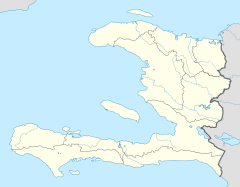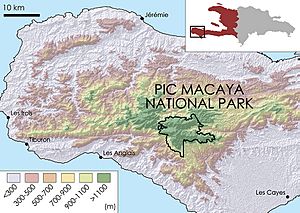Pic Macaya National Park facts for kids
Quick facts for kids Pic Macaya National Park |
|
|---|---|
| Parc National Pic Macaya | |
|
IUCN Category II (National Park)
|
|
| Location | Haiti |
| Area | 55 km2 (21 sq mi) |
Pic Macaya National Park (which is Parc National Pic Macaya in French) is one of the two largest national parks in the country of Haiti. You can find it in the southern part of Haiti, within a mountain range called the Massif de la Hotte. This special park protects Haiti's last remaining natural cloud forest, covering a huge area of more than 8,000 hectares (that's over 19,700 acres!). The mountains in the park are very rugged, and the highest point is Pic Macaya (or Macaya Peak), which reaches 2,347 meters (7,700 feet) above sea level. This makes it the second highest point in all of Haiti, after Pic la Selle. Most of the park is made up of two tall peaks: Pic Macaya and Pic Formon.
Protecting a Special Place
Pic Macaya National Park was first created in 1984. At that time, it was about 2,000 hectares in size. However, in March 2013, the park was made much bigger, growing to more than 8,000 hectares. This expansion was part of a project to better protect the park's amazing natural resources.
Many groups from around the world have helped to protect Pic Macaya. They have promised money to improve how the land is managed. This includes planting new trees in areas where they have been cut down. They also build structures to help stop soil from washing away when it floods. Most importantly, they work to protect all the different plants and animals that live there.
One of the biggest challenges for the park is something called "charcoal burning." This is when large areas of trees and plants are burned to make charcoal. Local people sometimes do this because they can sell the charcoal for a good price. This practice harms the forest and makes it harder to protect the park's unique environment.
Amazing Plants and Animals
The mountains in the Massif de la Hotte, where the park is located, are mostly made of karst (a type of limestone rock) and volcanic rock. This creates a special home for many plants and animals. Some of these species are endemic, meaning they are found only on the island of Hispaniola (where Haiti is located).
The park is a true treasure chest of life:
- Over 220 different kinds of birds live here.
- There are 141 different types of beautiful orchids.
- You can find 367 kinds of flowering plants.
- Scientists have even seen six species of frogs that were once thought to be extinct!
- In total, more than 6,500 different species of plants grow at Pic Macaya.
Forest Types and Life Cycle
The park has different types of forests depending on how high up you go.
- Humid Forests: From about 850 to 1250 meters high, you'll find humid forests growing on limestone rock.
- Higher Elevations: Higher up, the park has a mix of open pine forests and denser broadleaf cloud forests.
All three types of forests are home to many species found nowhere else. The main tree in the pine forests is the Pinus occidentalis, which is a type of pine tree. Sometimes, these pine trees also grow very tall in the cloud forests. In the pine forests, you might see blackberry plants, different kinds of ferns, and small shrubs and trees.
The main tree in the cloud forests is called bois tremble (Frodinia tremula). Other small trees and shrubs you might find include Garrya fadyenii, Myrsine coriacea, Brunellia comocladiifolia, Persea hypoleuca, Weinmannia pinnata, Cestrum coelophlebium, and different types of Miconia plants. There are also tree ferns like Cyathea harrisii and Alsophila minor, and a climbing bamboo called Arthrostylidium haitiense.
The type of forest you see depends on things like the soil, how much rain falls, how much sun the area gets, and if there have been fires or hurricanes. Frequent fires can help pine trees grow, but they can also kill young broadleaf trees.
See also
 In Spanish: Parque nacional de Macaya para niños
In Spanish: Parque nacional de Macaya para niños
- List of national parks of Haiti
- Haiti National Trust




